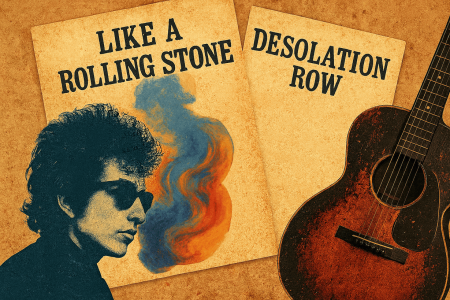Everyone knows “Like a Rolling Stone.” It is the song that changed everything. Critics call it the moment Dylan went electric, broke the rules, and rewrote what a single could be. It has topped lists for decades, quoted and praised as one of the greatest songs ever written.
But there is another track on the same album that rarely gets the same spotlight. “Desolation Row” closes Highway 61 Revisited with over 11 minutes of vivid imagery, twisted characters, and strange poetry. It is darker, deeper, and harder to unpack. It might also be Dylan’s real masterpiece.
So why does “Like a Rolling Stone” get all the glory? And why does “Desolation Row,” despite being just as groundbreaking, often stay hidden in the background?
The Artistry Gap: Complexity vs. Catchiness
“Like a Rolling Stone” hits fast. It opens with a sneer, rides a sharp organ riff, and never looks back. The structure is tight. The lyrics are bold and direct. It is built for impact, made to grab attention.
“Desolation Row” works in a very different way. It takes its time. The song unfolds like a long, winding poem. Each verse introduces strange characters and dreamlike scenes. The listener has to lean in, listen closely, and piece things together. It does not explain itself. That is part of the power.
The music reflects this approach. Instead of the full-band sound of “Like a Rolling Stone,” “Desolation Row” is built around a gentle acoustic guitar, with only a soft bass and occasional lead lines. It sounds fragile and distant, almost like it was recorded in a different world. That quiet backdrop leaves space for the lyrics to take center stage.
And the lyrics don’t repeat. Each verse adds something new. There is no chorus to lean on. Just a steady flow of images, references, and strange turns of phrase. This structure makes the song feel more like literature than pop. It is harder to sing along to, but it stays with you in a different way.
Cultural Overshadowing: How One Song Ate the Album
When people talk about Highway 61 Revisited, they almost always start with “Like a Rolling Stone.” It was Dylan’s first big electric statement. The single hit the charts, made headlines, and rattled the folk world. It was short enough for radio play, loud enough to turn heads, and clear enough to quote. It became the face of Dylan’s shift from acoustic poet to rock icon.
In contrast, “Desolation Row” was too long for radio. It closed the album instead of opening it. It had no electric guitar, no chorus, and no easy way in. For many listeners, it was the strange, quiet end to an album full of noise and boldness.
The media helped shape this divide. Over time, “Like a Rolling Stone” was crowned Dylan’s signature song. Magazines, documentaries, and critics kept putting it on top. Rolling Stone magazine ranked it number one on their list of greatest songs ever. That kind of praise builds a story that sticks. It becomes the shorthand for Dylan’s genius.
Meanwhile, “Desolation Row” stayed in the shadows. It became a deep cut, something for the fans and the scholars. It was praised, yes, but in a different way—more hidden, less celebrated.
Lyricism: Weaponized Surrealism vs. Acidic Clarity
The lyrics in “Like a Rolling Stone” are direct. Dylan points the finger, and every line cuts. It’s a takedown of someone who once had it all but now finds themselves lost and alone. The language is sharp, sarcastic, and easy to follow. There is no mistaking the tone. It is confrontation turned into poetry.
“Desolation Row” works in a completely different way. The lyrics drift from scene to scene, packed with strange images and twisted references. There’s Cinderella, T.S. Eliot, Einstein, and the Phantom of the Opera—all placed in odd situations that seem to defy logic. It’s surreal, but not random. The images build on each other. They create a world that feels both broken and familiar, like a dream you only half understand.
Dylan is not just writing a song here—he’s building a universe. The meaning shifts depending on how you read it. Some see political commentary. Others find religious undertones, or a portrait of a society on the edge. The brilliance is in how open it is to interpretation.
While “Like a Rolling Stone” tells you exactly what it’s about, “Desolation Row” never does. It asks questions instead of giving answers. It rewards those who return to it again and again, each time catching something new.
The Masterpiece Hiding in Plain Sight
This isn’t about tearing down “Like a Rolling Stone.” That song earned its place in history. But it’s time to ask why “Desolation Row” doesn’t sit right beside it—if not slightly above. It’s longer, stranger, and more demanding, but it’s also richer. Every listen opens a new door. Every line carries weight.
“Desolation Row” is the kind of song that reveals its greatness slowly. It doesn’t chase attention. It builds a world, hands you the map, and lets you wander. That quiet complexity is easy to miss in a culture that values immediacy and clarity.
But Dylan didn’t write for the charts alone. He wrote to last. And “Desolation Row” is lasting in all the ways that matter. It’s not the loudest song on the album. It’s just the one that keeps echoing long after the record ends.
